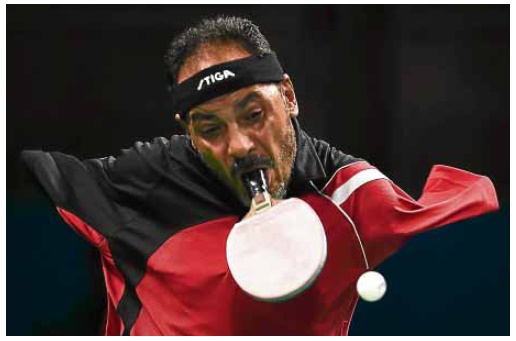No arms? No problem for table tennis Paralympian

EGYPT’S Ibrahim Hamadtou competes in table tennis during the Paralympic Games in Rio. He is the sole athlete who uses hismouth in the sport after losing both arms in a childhood accident. AFP
RIO DE JANEIRO—Egypt’s Ibrahim Hamadtou can swing a table tennis racket as well as the next Paralympian, but that’s not what makes him a sensation: Hamadtou holds the racket between his teeth.
The Rio Paralympics are full of stories of men and women who have trained their impaired bodies to compete at the highest level.
Yet Hamadtou, who lost both arms above the elbow in a childhood train accident, stands apart, the only table tennis player ever to try the feat.
Although he lost in his Paralympic debut, falling to the highly rated British world No. 4, David Wetherill, and then to Germany’s Thomas Rau, the wiry 43-year-old said he was elated.
“I’m just happy that I could come from Egypt to be here at the Paralympics and to play against a champion,” he told Agence France-Presse (AFP).
“I can’t express what my heart is feeling: I’m too happy.”
Agile foot, strong neck
Hamadtou, from the port city of Damietta, was 10 when he was injured.
“After the accident, he stayed shut up at home for three years. He wouldn’t go out,” said his coach of the last 20 years, Hossameldin Elshoubry.
A family friend tried to put the depressed teen back on track through sports. He still had two good legs, so football seemed obvious.
“But football didn’t work,” Hamadtou said.
His coach explained: “It was too dangerous. You see, with no arms, if you fall you have no way to protect yourself.” So Hamadtou tried table tennis, first by gripping the small paddle under the stump of his right arm.
“That didn’t work either,” he said, smiling.
Finally he attempted to clasp the racket handle in his mouth, much like someone might hold a flashlight when their hands are busy.
Except that table tennis—a lightning fast contest of whacking a ball back and forth over a tiny table—is nothing like holding a flashlight.
Hamadtou, however, found a way.
Table tennis players need to throw the ball to hit a serve, so he plays without a right shoe, using his toes to scoop the ball and toss it up, perfectly positioned. He then uses his strong neck to transform his head into the equivalent of an arm and his mouth into a hand.
“It took me three years to learn,” Hamadtou said.
“After that his life changed. You know, he went to school again after that,” coach Elshoubry said proudly.
His exploits have made him something of an internet sensation, starring in a YouTube hit called “Impossible is Nothing” which has been viewed more than 2.3 million times.
Legendary
Wetherill, who plays table tennis while holding a crutch to support his left side, is also famous in the Paralympic world. Video of him diving onto the floor to hit a winning shot in the London 2012 Games has been viewed on YouTube millions of times.
But the British star said he feels himself in the Egyptian’s shadow.
“He’s a legend in table tennis,” Wetherill said. “I was feeling the pressure, a bit jittery. [Then] you see people like Ibrahim and you can’t possibly feel nervous: He puts things in perspective—the things he can do.”
Hamadtou’s only problem in sporting terms is that he is too unique. A truly fair matchup at Paralympic level is almost impossible if the opponent has at least one arm.
“He’s the only one that uses his mouth,” his coach said. “There’s no one else. If there were five, six, seven players using their mouths, we’d make a new class.” That eventually might happen.
Back in Egypt, Hamadtou is training two armless boys, aged 10 and 12, Elshoubry said.
“He wants to give those two boys the skills that no one could give him when he was small.” TVJ
RELATED STORIES
Disabled athletes outpace healthy colleagues